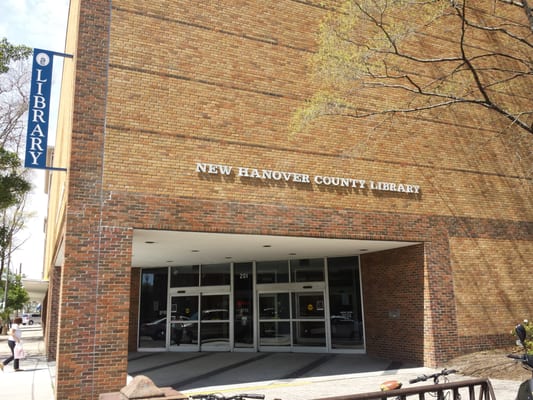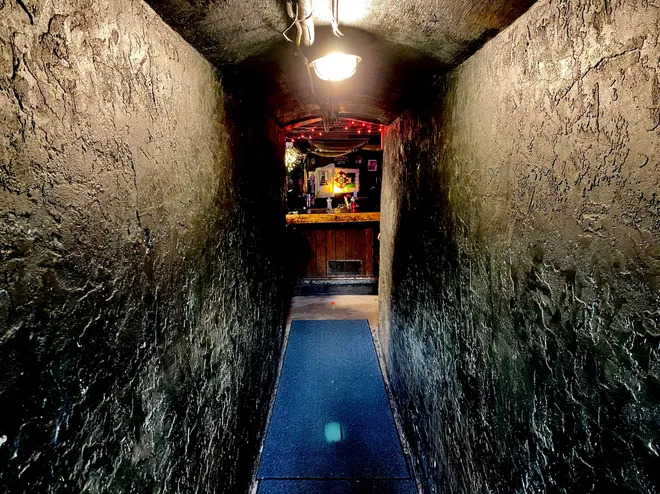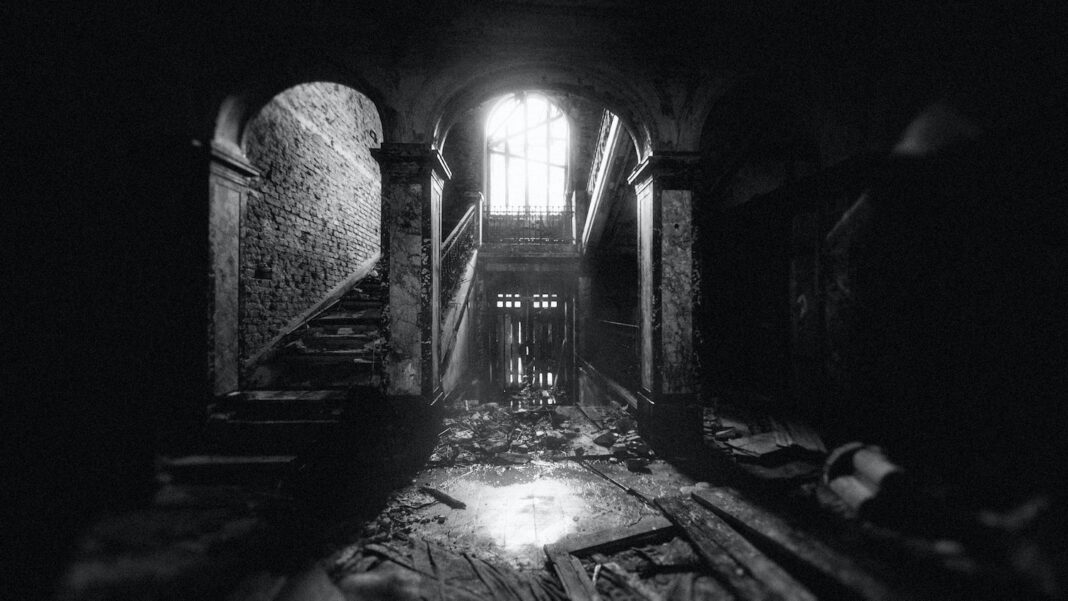Wilmington holds a city’s worth of ghostly tales. They drift along the cobblestone streets in the heart of downtown, often mistaken for a sudden, gentle breeze. Sometimes, they manifest as a glimpse of a face behind the lace curtains of an aging historic house. If you doubt your eyes, perhaps your ears will serve as evidence: ghostly footsteps, faint voices, and the creaks and groans of aging floors, doors, and gates create moments of eerie solitude.
Beware, for the act of sharing a ghost story is often what awakens these spirits. After all, who can resist the allure of attention? It’s only natural to be drawn toward the voice that whispers your name in the dark or to the person who reads your story aloud.
The New Hanover County Public Library

The library’s second-floor wing has gained a reputation for being haunted by spectral entities. The primary apparition is believed to be the ghost of a petite woman, often presumed to be a former library patron who was a frequent visitor to the local history room. Numerous employees and visitors have claimed to witness her ghostly presence over the years. Additionally, there have been reports of eerie phenomena, such as phantom footsteps and inexplicably moving books and pamphlets.
The library’s spectral activity doesn’t end there; it’s also attributed to a second ghost. This apparition is said to be the spirit of a man who met his demise in a duel during the 1800s. The site of the library was once the location of this man’s home. Visitors and staff have recounted experiences of sensing his restless presence through his nervous pacing, adding another layer of intrigue to the library’s mysterious history.
The Price-Gause House
This site stands out as one of the most haunted locations in all of Wilmington. Prior to the construction of a house on this property in 1843, it held the grim history of being Wilmington’s Gallows Hill, where numerous men met their end at the hangman’s noose. Following these hangings, it was customary for the bodies to find their final resting place right here, if no one came to claim them.
The property’s eerie reputation persisted when Dr. William Price chose to build his home at this site, allocating space for both his living quarters and office. Soon after the Price family settled into the house, they encountered a series of strange and unexplained events. Even to this day, echoes of phantom footsteps ascending the stairs and the lingering aroma of pipe tobacco waft through the air. Mysteriously, doors open and close of their own accord, leaving observers baffled.
Among the most active areas in the house is the upstairs office, which had served as a bedroom for many years. Oddly, the windows tend to frost up even during sweltering summer nights. From the exterior, passersby have glimpsed a peculiar sight – on clear nights, the word “HELP” appears etched in the frost on the upper-left window. To this day, no logical explanation has emerged for this phenomenon.
Supernatural activity isn’t confined to the indoors; it’s also been observed outside near the house. During investigations by the J & J Ghost Seekers, this area yielded significant electromagnetic field (EMF) readings. Evidential photographs of colored orbs and even what appears to be the silhouette of a person peering through a window while pulling a curtain have been captured. Visitors have described an unsettling sensation of pressure weighing down on them when spending time in the side yard. This is unsurprising, as the vicinity is believed to hold numerous unmarked graves.
Currently, the house serves as an office for an architectural firm, where the paranormal activity continues, consistent with a history spanning over 150 years. The employees at the architectural firm have affectionately nicknamed their resident ghost “George.” This site is also a featured stop on one of Wilmington’s local ghost walks, adding to its enduring mystique.
Fort Fisher
When night descends upon Fort Fisher, the Confederate bastion just to the south of Kure Beach, it casts an unsettling shadow that can send shivers down even the bravest of spines. Amidst the mounds and memories of one of the bloodiest battles of the Civil War, specters are known to roam. The ghostly apparition of Major General William H.C. Whiting, easily distinguished by his distinctive mustache and adorned coat with stars, is a frequent visitor to the fort he helped fortify. However, it’s not just Whiting’s presence that lingers in the eerie silence; the voices and visions of soldiers who once fought here have also been reported.
So why does Whiting’s spirit persist in haunting this place? The answer lies in the tragedy that unfolded within these fortress walls. Whiting had foreseen the impending bloodshed at Fort Fisher and pleaded for reinforcements, but his warnings went unheeded. After three harrowing days in January 1865, the fort finally succumbed to the Union forces. Wounded and captured, Whiting was held as a prisoner in New York for months before his passing. His spirit, it is said, yearned for home, and many years later, his wife, Katherine, granted his wish by relocating his remains to Oakdale Cemetery in Wilmington.
Poplar Grove Plantation
The historic peanut plantation known as Poplar Grove is steeped in ghostly lore, with apparitions frequenting both the main house and the tenant farmhouses. The bonds of family and homestead prove so potent that not even death can sever them. In this narrative, we delve into the tales of two of the most active spirits that haunt these grounds.
One of the lingering souls is that of young David Foy, the eldest son of the family, whose hubris echoes through the ages as palpable energy within the house. Rebelling against his Unionist father, David chose to join the Confederate Army but met a swift demise from typhus upon his return home. According to numerous accounts, his spirit lingers, perpetually embittered, stomping around the front office where plantation matters were once conducted.
Nora Foy, the wife of David’s brother, J.T., may well have endured her own haunting experiences during her lifetime. A resolute and strong-willed woman, she bore the heart-wrenching loss of four children, each passing away within days of birth. Undeterred, Nora carried on, eventually taking on the role of postmaster, always carrying a small pistol. Recognizing that her bloodline would end with her, she raised her nephew to inherit the plantation. It is rumored that Nora’s benevolent and protective spirit dwells in the upstairs children’s bedroom, watching over her charges.
St. James Episcopal Church
Historical accounts tell a chilling tale of a man, mistakenly declared dead, and subsequently interred behind St. James Episcopal Church in 1739. Just five years later, the first graves took root in the cemetery out back, now shrouded in the eerie reputation of being one of the most haunted graveyards in the entire state.
Samuel Joselyn, whose unfortunate fate led him to a premature burial in the hallowed grounds of St. James Episcopal Church Cemetery in 1810. The tale begins with a young man who had a heated argument with his wife at a hunting lodge situated in the Honey Island Swamp, eight miles north. In a rash decision, he rode away on horseback, venturing into the swamp in the heart of the night, in the midst of winter. As horses lacked headlights, it was an understandably eerie journey. Tragically, his lifeless body was discovered the following day by a search party. Cold, frozen, and lying in four inches of water, he was laid to rest in the St. James Episcopal Church Cemetery
For three consecutive nights, Joselyn materialized in the dreams of two of his friends, imploring them with each visit to unearth his body. Eventually, they succumbed to his wishes. When they discovered the horrifying truth, the police patrolling the area heard the boys’ anguished cries. The man lay in a large dried puddle of blood, his fingers ripped to the bone.
Joselyn had fought relentlessly to claw his way out from the confines of a six-foot-deep grave, a slow and agonizing suffocation that found confirmation in the coroner’s findings and remains documented in Wilmington’s history.
Now, two centuries later, visitors assert they have witnessed a shadowy apparition, leaning upon a tombstone in close proximity to Joselyn’s burial site. To many, this ethereal figure is perceived as Joselyn’s lingering spirit, continuing to haunt the grounds of St. James Cemetery, the very place he was abandoned to his fate as one of the departed.
Bellamy Mansion
The Bellamy Mansion, a splendid Antebellum residence in downtown Wilmington, has the power to draw visitors from all corners of the country. From the onset of the American Civil War through the period of reconstruction and the subsequent modernization of Wilmington, this mansion has silently witnessed the city’s darkest times.
Guests, upon ascending to the upper floors of the home, occasionally report an unsettling atmosphere. Their unease is not unfounded; Ellen Douglas Bellamy, the final member of her family to own the house, resided there until her passing in 1946. During her time, Ellen adhered to a particular daily routine. She would sit down to peruse the daily newspaper, her fingers darkening with fresh ink. Upon completing her reading, she would rise to switch off the lights, leaving her smudged fingerprints on the wall. To this very day, it is said that Emma’s fingerprints continue to manifest for inquisitive visitors
Thalian Hall
Thalian Hall stands atop a historic sand dune, believed to be the resting place of native Americans. Evidently, during renovation work in 1988 and 2010, skeletal remains were uncovered beneath the theater’s floor.
Over the years, Thalian Hall has undergone numerous restoration and renovation projects to ensure its continued use and relevance for the artistic community and the broader public. For those who were passionate about the arts during their lifetimes, it’s not uncommon for them to want to remain connected, even in the afterlife. They linger to relish in the performances of live musicians and actors or to find ways to support the artists and management teams overseeing the performing arts venue where it all takes place.
This theory provides a plausible explanation for the identities of the spirits that have been reportedly sighted within the confines of this building.
Throughout the years, during rehearsals for various productions held on the Main Stage, actors and actresses have frequently recounted encounters with these ethereal beings. These entities often manifest as distinct apparitions, dressed in the elegant attire of the Edwardian era, or their strong presence is palpable. They seem to enjoy strolling through the balcony during rehearsals, perhaps indicating to the actors on the Main Theatre stage that they are watching, akin to supportive stage parents.
The unseen presence of these three entities has been notably felt in various areas, including backstage, dressing rooms, restrooms, corridors, and the main lobby. Those involved in productions have described encountering “cold spots,” as well as hearing eerie sounds and echoes of disembodied voices.
Lula’s Pub

Lula’s is a subterranean bar located at the southern tip of downtown Wilmington, appreciated for its relaxed ambiance and hidden, underground charm. Even the entrance, a dimly lit, lengthy corridor leading below ground, offers an intriguing experience in itself.
Lula’s has earned its reputation as a popular destination for ghost tours and haunted pub crawls due to the eerie encounters said to have occurred on the premises, which is also shared with The Little Dipper.
The legend of Cooter revolves around a 19th-century slave who had a persistent tendency to escape from his owner’s plantation outside of Wilmington. After numerous failed attempts to flee through the city’s port, the tale suggests that the enraged owner either severed Cooter’s feet on the property that now houses Lula’s or returned later to have him executed there.
It is believed that Cooter’s spirit continues to haunt the location at the intersection of Front and Orange streets. Many patrons have reported catching a fleeting glimpse of him in the bar’s mirror or feeling his presence in the corner of this historic basement turned bar.
The Latimer House
Each year, this historic home fully immerses itself in the eerie spirit of Halloween with its Victorian Mourning program, shrouding the house in black just as it would have been when mourning the loss of a family member. The history of this place is marked by profound sorrow, as it was once the home of Zebulon and Elizabeth Latimer, who tragically lost five of their nine children before they reached the age of five. Guests have shared accounts of seeing the spectral forms of children peeking out from upstairs bedrooms, and passersby on the street have claimed to witness the ghostly visages of children in the windows on the upper floor.



